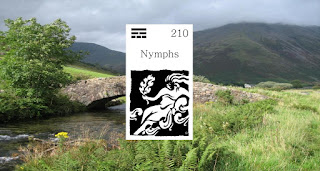Sun god (god of the Sky)
The power and return of the sun has been acclaimed and honoured for thousands of years. The warmth and light of the sun kindles the life-giving potential of the earth's biosphere. The sun's qualities are majesty, radiance, fertility, and beauty.
Invoking the Qualities of Power and Radiance.
IF YOU ARE DRAWN TO THIS ORACLE, you are sensing a fiery power emanating toward you or from within you. You marvel at the majesty of the sky world and the delicate fabric of life stirred by sunlight. You cannot seem to get enough sunlight. The brilliance of light attracts you. You may want to wear bright jewelry, or even be attracted to precious gems, especially diamonds.
The power of the sun to give light and warmth and its return each day have been revered for thousands of years, from the time of the Bronze and Iron Age Celts. Portrayed as a spoked wheel or swastika, the sun rolls across the firmament pulled by a chariot and team of horses. Among the Romanised Celts, a powerful sky god brandishes his solar wheel as a shield as he crushes the head of a monster with his foot or hand. The sun god signifies majesty, power, radiance, fertility, and beauty.
The sun gives warmth, light, and cycles to the year and is therefore associated with the giving of life, fertility of the crops, and the conquering of menacing forces. Complementary to the earth's primal power over life, the sun touches the earth and sparks the life already there. From archaeological evidence from the Bronze and Iron Age through the mythological period, the allusion to sexual coupling is obvious: the warmth of the sun enters the moist interior of the earth where life begins. Solar images adorn the bodies and are conveyed by goddesses and gods alike. In the Camonica Valley in northern Italy, the Celts of the late Bronze and Iron Age carved on cave walls solar images, round disks or spoked wheels held aloft or volleyed by human figures. The Gundestrup Cauldron bears the image of a magnificent sky god portrayed as being upheld, perhaps conveyed, by a wheel. Small clay figures of young goddesses are affixed with sun wheels surrounding their bodies or adorning their breasts, bellies, and thighs. Images of the sun and earthly abundance appear to harmonize in the Celtic imagination. Though sun images are primarily associated with male deities and images of earthly abundance with mother goddesses, it is not uncommon to find goddesses associated with sun wheels and gods carrying cornucopias and signs of a prosperous harvest.
Images of the sun wheel and swastikas, sometimes accompanied by a chariot and horse, on cave walls, coins, and armour, distill in imagery the mythic portrayal of the sun conveyed across the sky by a chariot and a team of horses. Perhaps only an animal as prestigious as a horse could accompany the sun. Epona, the horse goddess, is sometimes accompanied by solar imagery.
Solar deities in the Roman period, however, became increasingly masculine and fierce, though benevolent toward those they protected. Borrowing some of Jupiter's appearance from the Romans, the Celtic Jupiter is a powerful god, portrayed as standing and holding his solar wheel authoritatively. He frequently appears as a victor and as a god of generous mien and majesty, mounted on a horse and brandishing his (entirely Celtic) solar wheel like a shield against the enemy. Beneath him, pressed down by his foot or hand, is a monstrous, serpent like creature. The Celtic Jupiter is a warrior god, conquering the hideous forces troubling human life.
Two of the great fire festivals of the Celtic world, Beltaine at the coming of summer (May 1) and Lughnasa at the coming of the harvest (August 1), ritualise fire as the sun's semblance on earth. The cycles of the sun bring life. Celebrated into the nineteenth century, a midsummer celebration in Germany, for example, involved setting a wheel of straw on fire and rolling it down a mountain into the Moselle River. If the wheel reached the river still ablaze, a good wine harvest was foreseen. Similarly, the great fire festival of the Christian year, Easter, became associated in time with the sun. On Easter, the country people in Ireland rose early in the morning in hopes of seeing the "sun dancin' in the sky."
Drawing this oracle suggests that you have an opportunity to attract majesty and radiance to your character and attitude toward life. This is your time in the sun, a time to shine, bringing a sparkling quality to your own life as well as to others'. If you are attracted to a spiritual path, you may sense an inner light that propels you to focus more intensely on your meditations, prayers, or practices toward gaining enlightenment.
The sun's constancy and radiance invariably help to instil confidence and assurance. Positioning your life within the sun's beneficence brings balance to the flow of ordinary life events. In sensing the constancy of movement beneath change, hard times will bestow resilient and bountiful times, steadiness, and hope. By mindfully drawing closer to the sun's radiance, your life will seem more buoyant, majestic, powerful, and inspiring.













